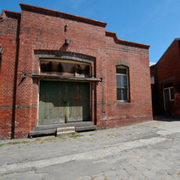Throughout 2019 we will be highlighting projects funded by the RAD (Records Access Documentation) Grants.
For people who spent time in out-of-home care as children, photographs and mementos are a scarcity, and highly valued. Care Leavers often don’t have images many of us take for granted – class photographs, pictures of homes and backyards, childhood activities captured.

Laundries, Magdalen Asylum, Convent of the Good Shepherd, Abbotsford
Where records can be sparse, traumatic, or absent, photos provide an important link to the past. For those relying only on their memories to piece together their past, a menu from a ‘home’ they lived in, the faces of long-forgotten friends, or the image of a place no longer accessible to them can help rebuild the experience of childhood.
Good Shepherd’s Photo Access Project will improve access to photographic, media and contextual information in their archives by:
- Professionally surveying their media collection
- Scanning, describing and indexing Care-Leaver related photographs and other images in their historic collection, and
- Tracing and documenting related contextual resources within the archival collection that are of value to Care Leavers, including undiscovered resources.
This will mean that Care Leavers have improved access to photos which will be better indexed, and available in both digital and printed copy.
Good Shepherd will also record information from Care Leavers themselves to better identify photos. When Care Leavers remember details about a person, place or event, this information will be recorded and indexed. Where people’s names aren’t known, if they are recognised by those that were in “care” at the same time, their names can then be recorded – people who thought they had no childhood photos of themselves may then be able to find them.
A survey of archival documents intends to provide more information about people’s time in “care”. This information will provide a context to the photos, and help build people’s memories and understanding of their childhood. This survey is a direct result of feedback from Care Leavers looking to fill gaps in their knowledge about their own childhood.
Improving indexing and information of and about records also means that Care Leavers can expect to receive records, including photos, faster than previously possible. The wait between applying for and receiving records can be long and often very stressful. Projects that decrease these waiting times can have a significant positive impact on those trying to access records of their childhood.
